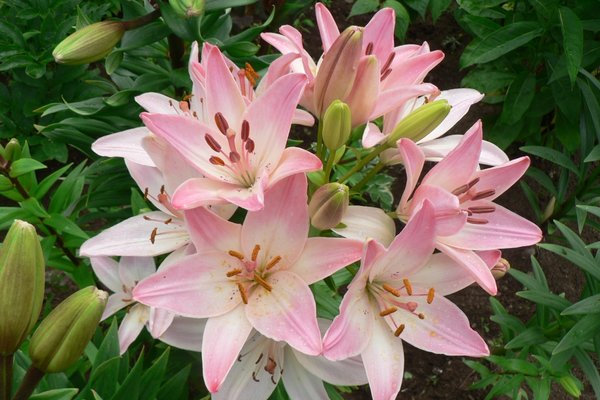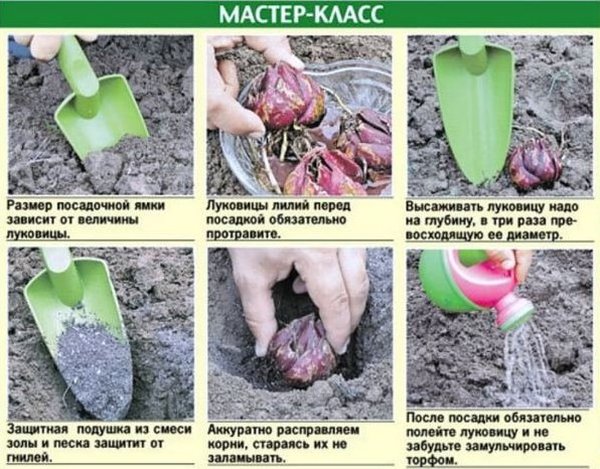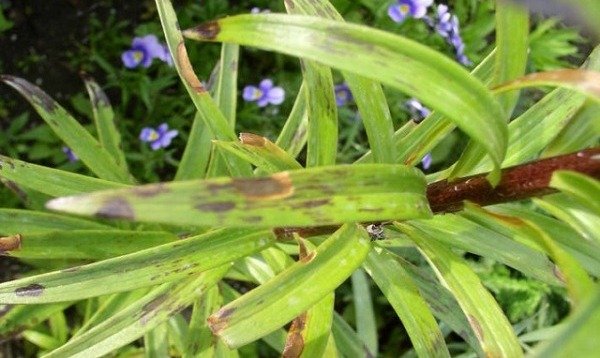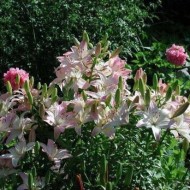Newbie tips for planting and growing the Marlene Asiatic Lily
Content
Characteristics and description of lily Marlene
Marlene is a hybridization of an Asian variety and a long-flowered lily. The cultivar, which quickly received positive reviews, was named after a German song from World War II "Lily Marlene".

According to the botanical description, this is a tall plant with vertical shoots 0.9-1.2 m long. Growing together, they form a thick stem, densely covered with grassy green foliage. The leaf plates are alternately seated, lanceolate, with sharp tips, up to 13 cm in size and a little more than a centimeter wide.
On one peduncle, up to hundreds of six-petalled bell-shaped buds grow. In the center, they have a creamy white color, which, closer to the edges, gradually turns into more saturated pink shades. During flowering, the aroma of the Marlene variety is completely absent. After flowering, seed pods filled with flat seeds form on the stems.
Video "Planting and growing an Asiatic lily"
In this video, an expert will tell you how to properly plant an Asiatic lily and care for the plant.
Advantages and disadvantages of a flower
The artificially bred Marlene lily is almost impeccable and attracts attention with a large list of advantages. So, among the many positive qualities of the plant are called:
- early flowering period;
- giant inflorescences;
- a tendency to fasciate;
- high decorative qualities;
- frost and drought resistance;
- immunity to disease;
- easy reproduction;
- unpretentious care.
The lack of smell can be attributed to disadvantages, however, for representatives of the Liliaceae, this is rather a plus than a minus.
Features of agricultural technology of the Asian multiflorous lily Marlene
Since the hybrid is undemanding to the conditions of detention, even a beginner can cultivate a flower in his garden plot. We will describe the basic agrotechnical rules below.
Storage and preparation of bulbs for planting
The bulbs are dug up in late autumn after the green part has completely died out, treated with a concentrated solution of potassium permanganate. After drying, they are sprinkled with sawdust, and then sent to the cellar for storage.
In the spring, the planting material begins to harden. To do this, the container is taken out into a room where the air temperature is about +5 ° C, and kept under such conditions for 14-21 days. Immediately before planting, the bulbs are treated with a pink solution of manganese, and then dipped in "Kornevin" overnight.

Optimal growing conditions
The multi-flowered lily Marlene is a light-loving plant, so a well-lit place for planting is chosen.
The plant thrives best on nutrient soils with good permeability. In this case, acidity can be neutral or slightly acidic. The flower loves moderate humidity and calmly tolerates temperatures from +5 ° C to +30 ° C. However, for all its frost resistance, the cultivar is not adapted to winter in the open field.
Landing dates and rules
You can plant Marlene on the site from mid-spring. The more precise time depends on the climatic conditions and the desired flowering time. In order for the bulbs to quickly adapt, and the first shoots to appear as early as possible, you need to follow the planting algorithm:
- dig up the site, bringing the soil to the desired conditions (nutritious, not heavy, loose);
- prepare the planting holes by digging holes 10-20 cm deep at intervals of 15-30 cm from each other;
- deepen the bulbs, and cover the top with earth;
- moisten the planting site well;
- sprinkle a small layer of sand on top.
Watering and soil care
For normal growth, the Asian hybrid needs regular, moderate moisture. This is done as the 20-centimeter soil layer dries out. Usually, two waterings per week are enough for the plant, but in extreme heat, the procedure is carried out daily, in the morning or after sunset. At the same time, the water should be settled, slightly warm.
So that the bulbs do not rot, and the plant receives enough oxygen and nutrients, the soil must be periodically loosened. If this is not possible, you can lay out a mulch layer of sawdust, dry grass, peat or sand under the bush. This will help the earth retain its loose structure longer.
- Usually, the plant needs two waterings per week.
- Lilies are not afraid of the lack of nitrogen-containing fertilizers
- Lilies need regular, moderate hydration
Pinching, pinching and pruning
Lily Marlene is one of the few varieties that does not need any of the listed processes. The only time pruning is done is in late autumn. Before digging out the bulbs, the plant is completely cut to the root.
Top dressing and stimulation
For the entire growing season, the cultivar is fertilized three times:
- with the appearance of the first sprouts, organic fertilizers such as humus or bird droppings are used;
- during the formation of buds, mineral complexes are introduced under the root, for example, "Formulex" or "Kemira";
- at the end of flowering, fertilize with potash-phosphorus compounds or wood ash.
Lilies are not afraid of the lack of nitrogen-containing fertilizers, but you should not completely abandon them.
Wintering a flower
The lowest temperature that Marlene can tolerate outdoors is at least + 5 ° C. Accordingly, in the regions of the middle zone, wintering in the garden plot for a hybrid is excluded. After wilting of the aerial part, the bulbs are dug up, processed and sent for storage until the new season.
Major diseases and pests, control methods
If you follow all agrotechnical rules for planting and subsequent care, the risk of contracting infections is practically zero. However, with excessive moisture or damp, cool weather, the following problems may arise:
- Gray rot. It manifests itself as gray-gray spots covered with gray-green mold. Bordeaux mixture or Oxyhom-type fungicides are used to combat the fungus.
- Rust. It looks like a speck on the leaf blades, which turns yellow-brown over time. The diseased bushes are completely destroyed, and the neighboring ones are treated with Bordeaux liquid or "Fundazol".
- Fusarium. It affects the underground part of the plant, causing tuber rot. It is no longer possible to save a sick flower, and therefore they dig it up and burn it. For prevention, neighboring plants are treated with any fungicide.
Sometimes insects attack flower bushes. Frequent "guests" are spider mites, onion or lily flies, aphids, click beetles and squeaky beetles.To protect the plant, it is sprayed with an insecticide solution, for example, Actellik.
Often, underground pests can also spoil the hybrid. Most often these are bears or beetle larvae. An effective drug in the fight against parasites is "Medvetox".

Reviews about Lily Marlene
“When I was given the Marlene bulbs, I didn’t believe that exactly what was painted in the picture would grow. However, the next summer after planting, a powerful stem was formed, on which several dozen luxurious pale pink flowers later bloomed. "
“I have been growing the Marlene variety in greenhouse conditions for sale for a long time. Compared to other hybrids, it does not require special care and at the same time has the highest decorative qualities. "
Any grower can grow an incredibly beautiful variety of Marlene. Do not be afraid of difficulties, because if you follow simple agrotechnical rules, you can easily get a luxurious ornamental bush.



